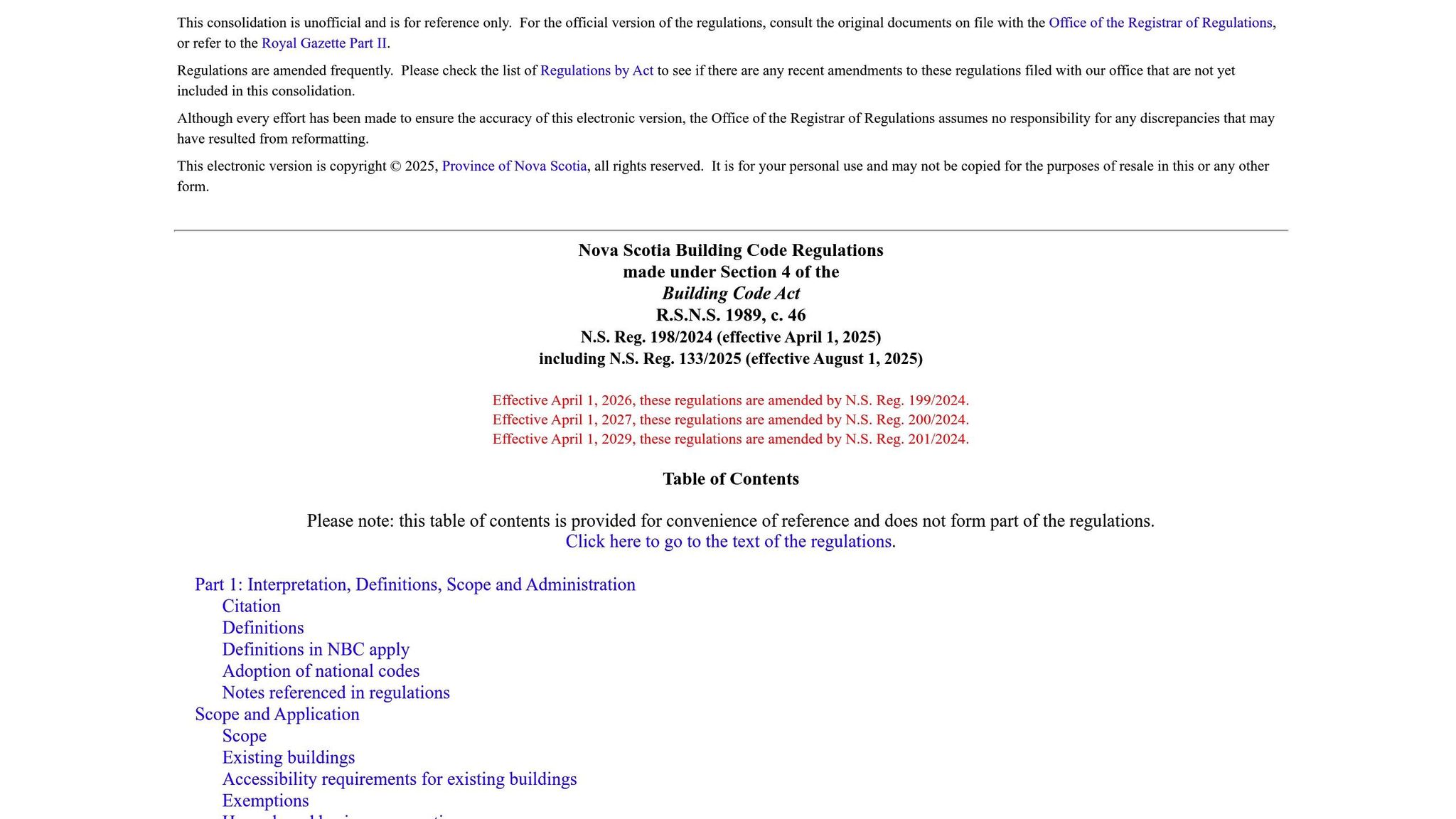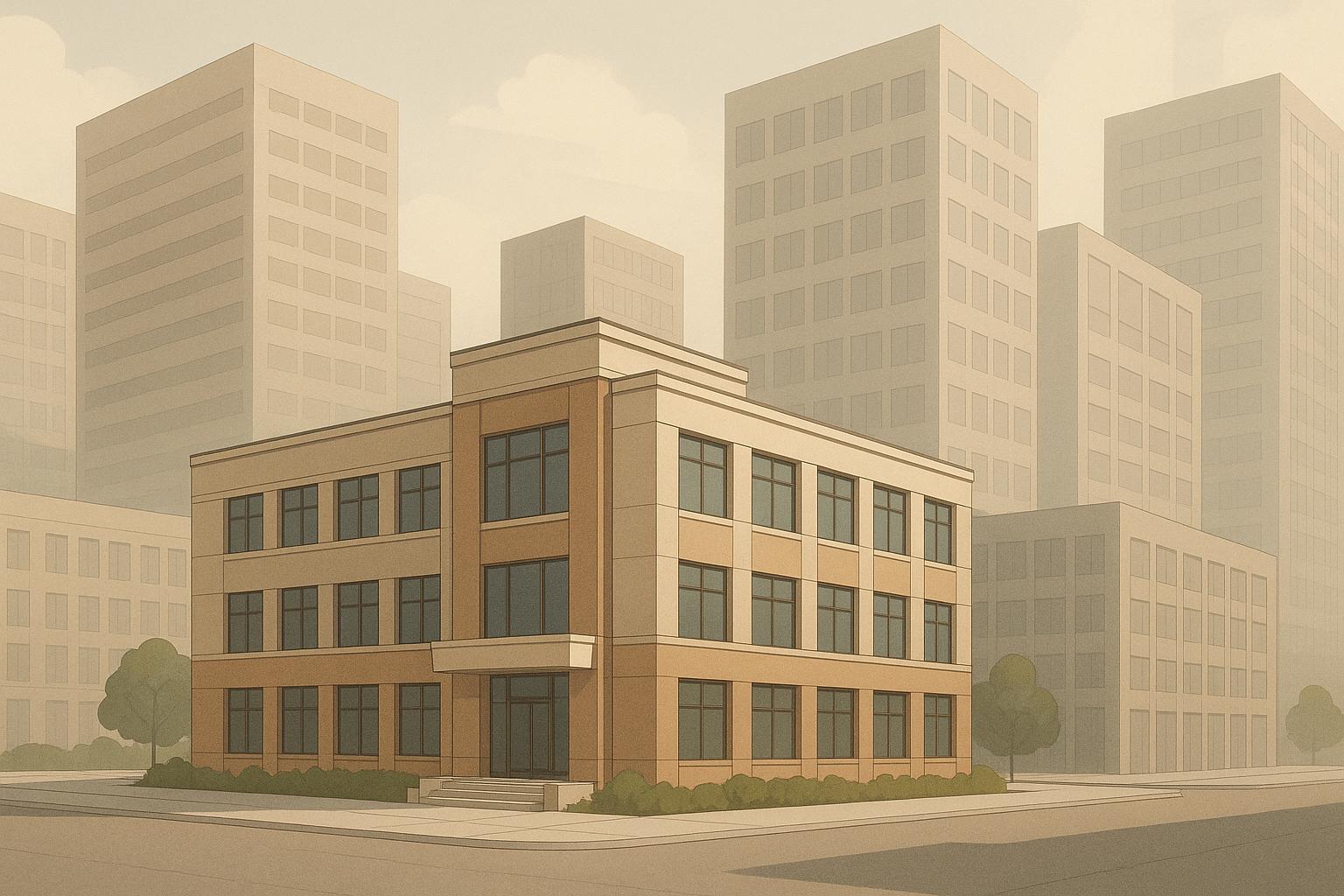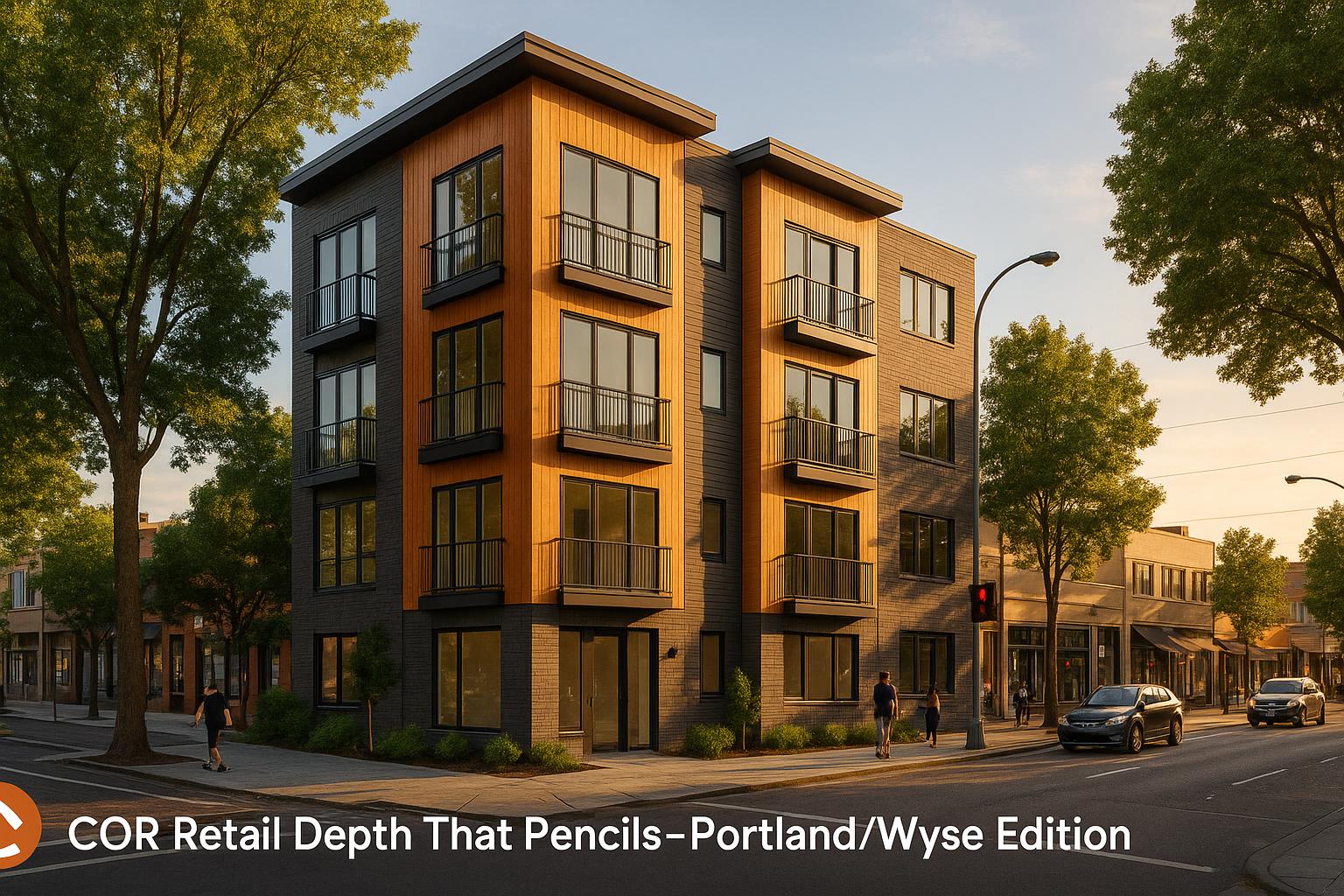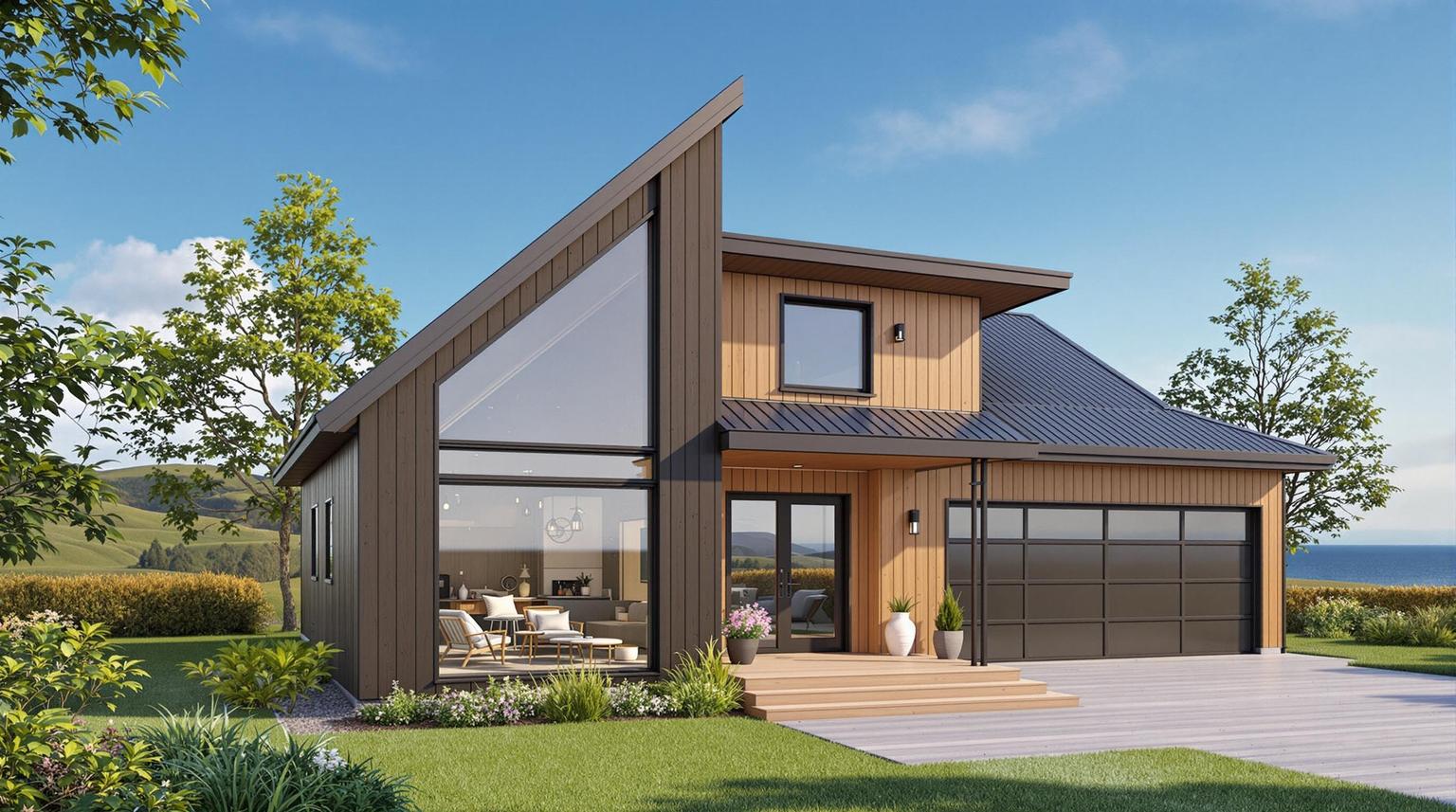Want to convert your property into a multi-unit rental in Nova Scotia? ER-2 zoning makes it possible - but only if you meet strict building code standards.
Here’s what you need to know:
- ER-2 zoning allows medium-density conversions without altering the building structure, creating rental opportunities while addressing housing shortages.
- Key challenges: Upgrading mechanical systems, meeting emergency exit (egress) requirements, and ensuring proper soundproofing between units.
- Mechanical stacks: Must comply with Nova Scotia Building Code and be placed to minimize noise while allowing easy maintenance.
- Egress compliance: Includes proper exits, fire-rated materials, and window alternatives for safety.
- Sound separation: Requires meeting strict STC (50) and IIC (50) ratings for tenant comfort, with better materials and testing ensuring results.
- Integrated design-build approach: Aligning architects, engineers, and contractors from the start avoids costly delays and ensures compliance.
The bottom line: Success in ER-2 conversions depends on careful planning, collaboration, and attention to detail. By addressing these elements early, you can boost rental income while meeting code requirements.
New 2024 Ontario Building Code Changes For Second Suites, Multiplex Conversions & ADUs/Garden Suites
Mechanical Stack Design and Construction for Code Compliance
Mechanical stacks serve as vertical pathways for plumbing and HVAC systems, connecting multiple floors. Ensuring these stacks meet the Nova Scotia Building Code standards [1] is critical. Non-compliance can lead to costly redesigns or failed inspections, so adhering to these rules is the foundation for any successful design.
Mechanical Stack Requirements for ER-2 Properties
For ER-2 properties, engineers are required to submit Commitment Certificates that verify their mechanical and plumbing designs align with the relevant codes [1]. This process highlights the importance of hiring skilled professionals who understand these regulations. Another key consideration is the strategic placement of stacks to balance sound control and maintenance accessibility.
Stack Placement for Sound Control and Access
Placing stacks thoughtfully can significantly reduce noise and simplify maintenance. According to the World Health Organization, indoor noise levels should stay below 50 dBA to reduce moderate to severe annoyance. A reduction of 10 dBA is perceived as halving the noise level [2]. To achieve this, avoid positioning stacks near main living areas, such as bedrooms, to minimise vibration and noise transmission. Additionally, ensure cleanouts are easily accessible to facilitate routine maintenance and repairs.
Common Stack Design Mistakes and How to Avoid Them
Meeting Egress Requirements in Multi-Unit Conversions
After designing a proper mechanical stack, the next critical step is ensuring that your project meets egress requirements. These standards are essential for tenant safety in ER-2 conversions, as they ensure occupants can leave the building quickly in emergencies. Compliance isn’t just about safety - it’s also key to passing inspections and avoiding costly redesigns or delays.
Nova Scotia Building Code Egress Standards

For buildings with more than four units or exceeding specific heights, two separate exits are mandatory. Exit doors must measure at least 810 mm wide by 2,030 mm high, and corridors should be around 1,100 mm wide to allow safe passage.
Fire-rated assemblies play a big role in egress design. For example, exit stairwells typically need a 1-hour fire rating, and corridors leading to these exits must have fire separation from adjacent spaces. In basements or upper floors, where stairwell exits may not be feasible, windows often serve as an alternative. These egress windows need a minimum opening of about 0.35 m², with no single dimension smaller than 380 mm. Additionally, the window sill must be low enough to ensure safe and easy exit.
Common Egress Design Errors
One of the most frequent mistakes is assuming that existing doorways already meet code. This often results in problems with exit spacing or inadequate fire-rated components, which can delay inspections and extend project timelines. Similarly, converting hallways without checking measurements can lead to corridors that don’t meet the required width.
Another common oversight is failing to install proper fire-rated materials along exit routes. It’s also important to keep exits clear of obstructions such as storage items, mechanical equipment, or poorly planned layouts. These issues can compromise the safety and accessibility of evacuation routes, creating significant risks and non-compliance concerns.
Internal vs External Exit Solutions: Cost and Compliance Comparison
Deciding between internal stairwells and external exit stairs can significantly impact both the project budget and the experience of future tenants. The best option depends on the building’s layout and financial considerations.
| Solution Type | Construction Cost | Code Compliance | Tenant Experience | Maintenance Requirements |
|---|---|---|---|---|
| Internal Stairwell | $15,000–$25,000 | Enclosed design with required fire ratings | Weather-protected, private access | Higher – includes HVAC, lighting, cleaning |
| External Exit Stairs | $8,000–$15,000 | Simplified fire separation, direct access | Exposed to weather, visible from street | Lower – occasional painting, winter upkeep |
Internal stairwells offer weather protection and a polished tenant experience but come with higher costs due to fire-rated systems and additional maintenance needs like HVAC and lighting. On the other hand, external exit stairs are more affordable and simpler to construct, though they face challenges like exposure to winter weather and potential impacts on the building’s appearance.
The choice between these options depends on the building’s layout and the target tenant demographic. For properties with central hallways, internal stairwells might be the better fit. Meanwhile, buildings with complex interior configurations may benefit from external stairs. By carefully considering these factors, you can create a safe, code-compliant design that aligns with the overall goals of your conversion project.
Sound Separation Standards for Multi-Unit Rentals
After addressing egress compliance, it's essential to focus on sound separation. Effective soundproofing plays a key role in ensuring tenant satisfaction.
STC and IIC Rating Requirements
The Nova Scotia Building Code follows the National Building Code of Canada (NBCC) 2020, which outlines minimum sound separation standards for multi-unit buildings[1]. Meeting these standards not only enhances tenant comfort but also helps avoid expensive retrofits later on.
Sound Transmission Class (STC) measures how well walls and floors block airborne sounds like conversations, music, or TV noise. According to the NBCC, walls and floors separating units in multi-family buildings must achieve a minimum STC rating of 50[4][5]. However, the in-place measurement, called Apparent Sound Transmission Class (ASTC), should reach at least 47 to account for sound transfer through connections and surrounding elements[5].
"Airborne sound can travel directly through a wall/floor and therefore partitions separating two apartments or condominium suites are required to meet minimum STC 50." – SLR Consulting [5]
Impact Insulation Class (IIC) measures how well floor-ceiling assemblies reduce impact sounds, such as footsteps, furniture movement, or children running. While the NBCC sets a minimum IIC rating of 50 for these assemblies, it only recommends (without enforcement) aiming for an IIC of 55 for better performance[4][5].
The difference between these ratings can significantly affect tenant comfort. For example, partitions with an STC of 50 allow loud voices to remain intelligible and raised voices to be clearly audible. For mid-range rental properties, aiming for an STC of 55 and an IIC between 55 and 60 can provide a noticeable improvement in sound separation[5].
Effective Soundproofing Methods and Materials
Wall Assembly Improvements begin with proper insulation. Materials like fibreglass and mineral wool can significantly enhance STC ratings, while spray foam insulation offers limited soundproofing benefits[3]. Adding insulation to an uninsulated wall can increase the STC rating by about 8 points[3].
Decoupling techniques can also make a big difference. Resilient channels, for instance, can raise the STC rating by roughly 5 points, while resilient isolation clips provide even better results. For areas requiring higher sound separation - such as bedrooms - chase walls (two separate wall frames with a gap between them) are highly effective.
Specialized materials can further improve performance. Sound-damping gypsum boards, like Gold Bond® SoundBreak XP, help dissipate vibrational energy, boosting STC ratings. Although these boards cost more than regular drywall, they deliver measurable improvements in soundproofing[3].
Floor-Ceiling Assemblies require tailored solutions to address impact noise. For example, using carpet with a 7mm rubber underlay can increase the IIC rating by 25 points or more compared to hard flooring[4]. If hard surface flooring is used, options like concrete toppings, resilient underlayments, or ceiling isolation systems become essential.
Low-frequency noise, such as the rumble from footsteps or appliances, can be particularly challenging in mid- to high-end properties. Spring isolators for ceilings and cavity walls are effective at managing these low-frequency sounds[5].
Once your soundproofing methods are in place, scheduling third-party acoustic testing is a crucial final step to confirm performance.
Testing and Verification for Sound Separation
Merely meeting code requirements on paper doesn’t guarantee real-world results. Third-party acoustic testing ensures your soundproofing measures achieve their intended performance, saving you from costly fixes after tenants move in.
Field testing evaluates the actual performance of installed assemblies. Acoustic consultants use specialized tools to measure both ASTC and Apparent Impact Insulation Class (AIIC) ratings. This process can uncover issues like poorly sealed electrical boxes, gaps in insulation, or missing acoustic caulking - problems that can significantly reduce soundproofing effectiveness if left unresolved. Addressing these issues during construction is far more cost-effective than making corrections after the fact.
Third-party testing is especially important if you’re marketing your units as having superior soundproofing. Verified performance ratings provide documented proof to support these claims, helping to minimize tenant complaints.
Timing is key. Conducting acoustic tests during construction allows you to fix any problems before finishes are installed, ensuring your assemblies meet the desired performance levels from the beginning.
While meeting minimum code standards sets a baseline, investing in advanced soundproofing techniques and thorough testing can protect your reputation and rental income. Strong sound separation, combined with systematic testing, adds long-term value to your property.
sbb-itb-16b8a48
Integrated Design-Build Approach for ER-2 Conversions
When it comes to ER-2 conversions, where factors like stack placement, egress, and sound isolation are deeply interconnected, using an integrated approach simplifies the process. These projects demand strict compliance with building codes, requiring architects, engineers, and contractors to work in sync. An integrated design-build model eliminates the inefficiencies of fragmented methods by uniting design and construction teams from the outset.
Fragmented vs. Integrated Construction: How They Differ
The traditional design-bid-build approach often leads to scheduling conflicts, budget overruns, and miscommunication. With multiple professionals - architects, structural engineers, mechanical engineers, contractors, and subcontractors - working independently, coordination issues can pile up. For instance, misaligned stack placement or conflicting structural needs can result in costly change orders and delays.
In contrast, integrated design-build brings all stakeholders together from the beginning. This model allows the construction team to offer input during the design phase, addressing potential problems early and avoiding disruptions later in the project.
One standout example of this approach is Ryan Companies' work on an acute care hospital expansion in April 2024. By involving their construction team early, they condensed a five-phase project into three phases, shaving three to four months off the original schedule. Early collaboration also flagged potential inspection hurdles, saving both time and money [6].
This level of integration is especially critical for ER-2 conversions. When architects, mechanical contractors, and structural engineers collaborate from day one, issues like HVAC routing, egress planning, and soundproofing are resolved upfront, eliminating the need for expensive redesigns.
Fixed-Price Construction with Guaranteed Timelines
Budget unpredictability is a common problem in construction, with residential conversions often exceeding initial estimates by 30-60%. Fixed-price contracts with timeline guarantees offer a solution by shifting responsibility for overruns and delays onto the builder.
Helio Urban Development, based in Nova Scotia, is a prime example of this model in action. They offer fixed pricing at $160,000 per unit and a six-month construction guarantee. If delays occur, they face financial penalties of up to $1,000 per day. This approach has kept their 31 completed units free of cost overruns.
Consider the financial impact of delays: A fourplex earning $1,950 per unit in monthly rent loses $7,800 for every month the project is late. Fixed timelines with penalties ensure builders stay focused on the schedule, rather than juggling multiple jobs at once.
In traditional cost-plus construction, owners bear the risks of material price hikes, labour shortages, and scope changes. Coordination issues often lead to frequent change orders, turning an originally planned eight-month project into an 18-month ordeal.
With fixed-price construction, builders assume the risks, which forces them to plan more thoroughly and coordinate effectively. Many companies using this model invest in advanced scheduling tools and quality control systems to safeguard their margins.
Unified Accountability Lowers Project Risk
Beyond budget and schedule certainty, integrated design-build reduces risks by creating a single point of accountability. Fragmented contracts, by contrast, spread responsibilities across multiple parties, increasing the chances of delays and added costs when issues arise.
In an integrated model, the owner, design team, and construction crew collaborate from the start. This unified approach ensures potential conflicts - like a mechanical stack interfering with egress requirements - are identified and resolved during the design phase. Similarly, soundproofing strategies are incorporated into the structural and mechanical plans early on, preventing surprises during construction.
Quality control also benefits from this streamlined approach. For example, Helio Urban Development employs a rigorous inspection process that includes five site visits by a Professional Engineer and a final inspection chosen by the property owner. Daily photo updates further ensure that any issues are addressed immediately, rather than during the final walkthrough.
In Nova Scotia, where labour shortages complicate scheduling, integrated teams are better equipped to manage trade coordination. They can minimize downtime and keep skilled workers productive throughout the project.
This level of coordination is especially important for ER-2 conversions, where meeting building code requirements involves balancing multiple systems. By aligning mechanical, structural, and architectural elements from the start, passing inspections becomes a predictable outcome rather than a gamble.
Conclusion: ER-2 Conversion Success Factors
Converting properties to meet ER-2 compliance demands a precise and well-coordinated approach. Mechanical stacks, egress routes, and sound separation must work together as interconnected systems to align with Nova Scotia's building codes. Without this integration, both compliance and profitability can be at risk.
Avoid These Common Pitfalls
Mechanical stack placement is often the costliest mistake in ER-2 conversions. Placing stacks too close to bedrooms can lead to noise complaints, while poor planning around access can result in expensive redesigns and ongoing maintenance headaches.
Egress violations are another common hurdle. Property owners frequently misjudge corridor width requirements or miscalculate the travel distances to exits. Modifying internal stairwells often triggers additional fire separation requirements, which can blow budgets. While external fire escapes may seem like a cost-effective solution, they often lead to higher long-term maintenance expenses and can detract from a property’s visual appeal.
Sound separation failures can significantly impact rental income. Achieving the required STC 50 and IIC 50 ratings involves more than just adding insulation - it requires careful construction methods and high-quality materials. Cutting corners in soundproofing can lead to tenant dissatisfaction, increased vacancies, and lost revenue that could amount to thousands of dollars annually.
The biggest mistake, however, is treating these systems in isolation. When mechanical contractors design stacks without considering soundproofing, or architects plan egress routes that conflict with HVAC systems, the lack of coordination leads to costly delays and complications. These challenges highlight the importance of a unified approach to ER-2 conversions.
Why Integrated Design-Build Works Better
Helio Urban Development provides a compelling example of how an integrated design-build model can lead to better outcomes. By completing 31 units without cost overruns, they’ve shown how unified accountability can streamline ER-2 conversions. Their fixed-price construction model - at $160,000 per unit - includes penalties of up to $1,000 per day for delays, a level of assurance that’s only possible when all teams work together from the start.
This approach is especially effective for ER-2 projects, where compliance involves multiple trades. By having mechanical engineers and architects collaborate early in the design phase, stack placement can simultaneously address soundproofing and egress requirements. Structural modifications can also account for soundproofing needs from the outset, preventing costly surprises during construction.
Meeting Code Requirements While Maximising Profits
An integrated approach not only ensures compliance but also boosts profitability. ER-2 compliance isn’t just about passing inspections - it’s about creating rental spaces that attract tenants and generate steady income. Well-planned mechanical systems reduce maintenance issues and tenant complaints. Thoughtfully designed egress routes enhance safety and can lower property insurance rates. High-quality soundproofing supports premium rents, while poor sound control leads to higher turnover and vacancy rates.
The financial stakes are significant. For example, a fourplex with units renting at $1,950 each loses $7,800 for every month of construction delays. To achieve a 12–20% annual ROI, ER-2 conversions must balance strict code compliance with profitability-focused planning.
Ultimately, success in ER-2 conversions comes from viewing building systems as interconnected pieces of a larger puzzle. When mechanical stacks, egress routes, and soundproofing are planned together from the start, compliance becomes predictable, and profitable outcomes naturally follow. This integrated approach transforms potential challenges into opportunities for long-term success.
FAQs
How can I ensure proper sound separation in ER-2 conversions to keep tenants happy?
Achieving Effective Sound Separation in ER-2 Conversions
Creating proper sound separation in ER-2 conversions is crucial for keeping tenants happy. To comply with building code standards - or even surpass them - walls and floors between units need to achieve a Sound Transmission Class (STC) rating of at least 55 dB. This rating ensures better acoustic privacy by cutting down on disturbances from airborne noise.
While the Nova Scotia Building Code provides guidelines for impact sound insulation, it doesn’t specifically address structure-borne noise. To tackle this gap, it’s important to use high-quality soundproofing materials and rely on tested construction methods. These steps help reduce noise transfer between units effectively. Beyond meeting inspection standards, proper sound separation also makes the space more comfortable and appealing for tenants.
What are the benefits of using an integrated design-build approach for ER-2 conversions?
The Benefits of an Integrated Design-Build Approach for ER-2 Conversions
Using an integrated design-build approach for ER-2 conversions streamlines the entire process by providing a single point of accountability. This approach ensures smoother communication and better coordination throughout every stage of the project. The result? Shorter timelines, better cost control, and fewer errors.
Traditional construction methods often require managing multiple contracts and juggling various responsibilities, which can lead to miscommunication and delays. In contrast, the design-build method aligns all critical components - like mechanical systems, soundproofing, and egress compliance - under one unified plan. This not only improves the overall quality of the project but also reduces unexpected setbacks and ensures more predictable outcomes. For property owners, this means an easier time passing inspections and creating rental units that are both profitable and appealing to tenants.
What challenges might arise in meeting egress requirements for multi-unit conversions in Nova Scotia, and how can they be addressed?
Meeting egress requirements for multi-unit conversions in Nova Scotia can be tricky without careful planning. Some common stumbling blocks include windows and doors that are too small or improperly sized, escape routes that are blocked, and failure to meet fire safety or accessibility standards. These issues can lead to safety risks, inspection failures, or pricey delays.
To steer clear of these problems, make sure every unit has a code-compliant egress window or door that offers a clear and unobstructed path to the outside. Pay close attention to the specific size, placement, and accessibility rules outlined in the local building codes. Connecting early with building officials and contractors who have experience in multi-unit conversions is a smart move. This proactive approach can help you avoid costly retrofits, keep your project on track, and ensure the safety and peace of mind of future tenants.



